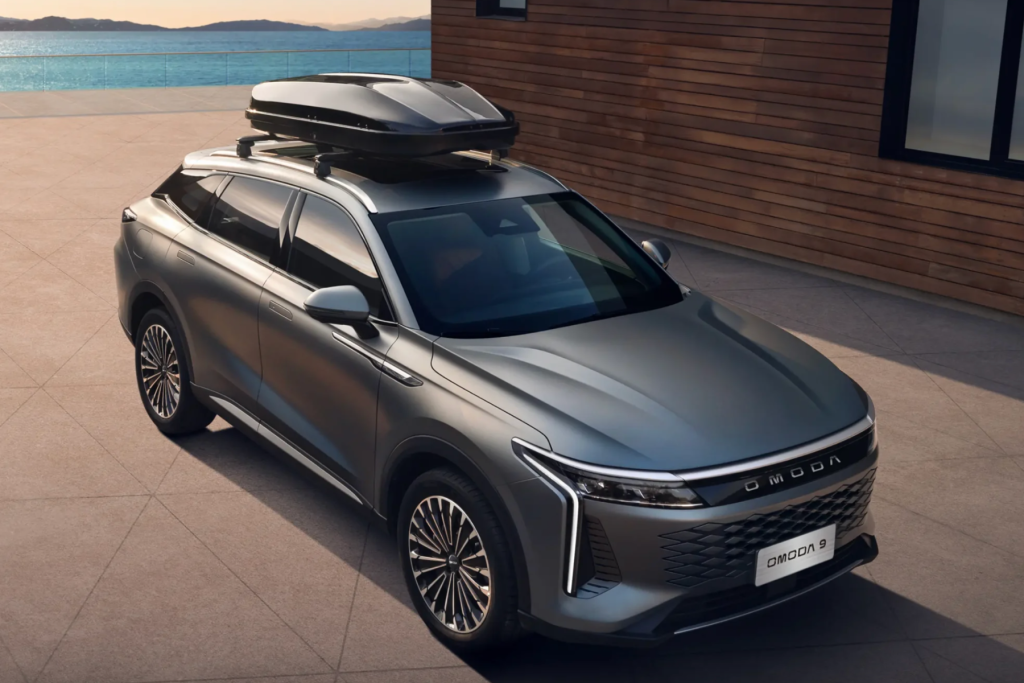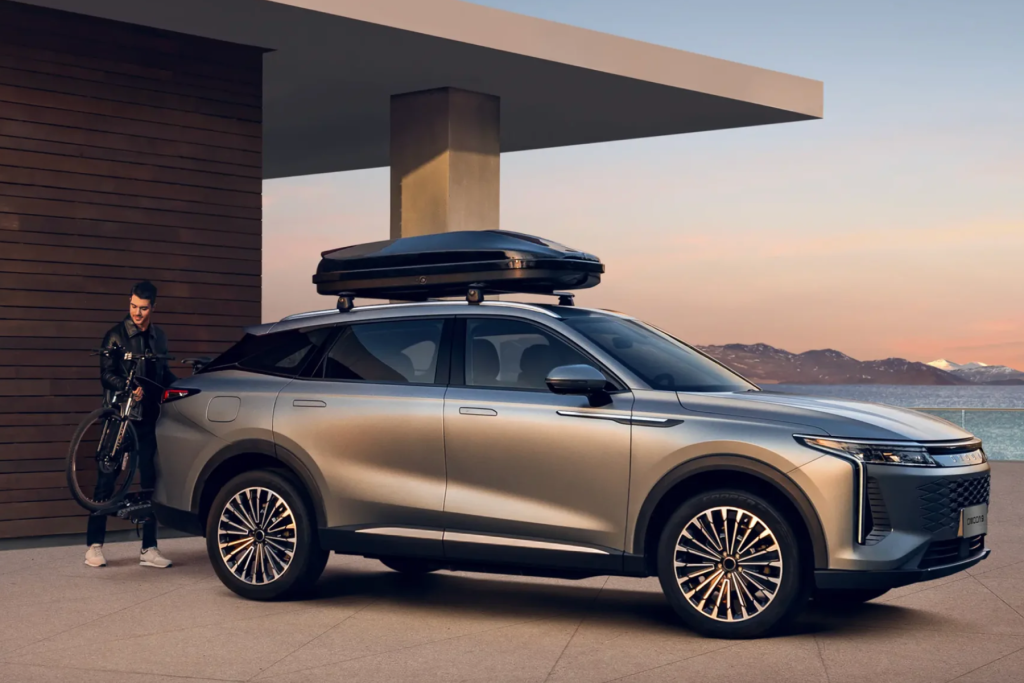What Is It?
The Omoda 9 is a new plug-in hybrid SUV from China, landing in the UK in 2025. It’s aimed at folks who want slick hybrid performance and loads of tech without forking out German badge money. Kicking off at £44,990, it’s quite a bit cheaper than other plug-in options like the Audi Q5 TFSIe or Volvo XC60 T8. Add in a bold design, generous kit list, and the backing of a seven-year warranty, and it’s clear Omoda is looking to tempt buyers who might usually shop premium but are open to something fresher and better value.

Exterior Design
First impressions? It’s got a bold, pretty upmarket vibe, with sharp LED lights and a big front grille that gives it some presence. It leans more towards the swoopy-coupe SUV look, rather than the usual boxy shape, so it tries to look as sporty as it is practical. The size is proper decent too—4,775 mm long and 1,920 mm wide, with a big 2,800 mm wheelbase—so it feels more mid-to-large than compact. It’s kitted out with 20-inch alloys, sleek flush panels, and double-glazed glass to keep road noise and wind whistle to a minimum.

Engine & Powertrain
Pop the bonnet and you’ll find a 1.5-litre turbo petrol engine working together with three electric motors—two up front and one at the back—to give it proper all-wheel drive. All in, it’s got 449 bhp and torque somewhere in the 700–915 Nm range, depending on who you ask. That gets you from 0–62 mph in just 4.9 seconds, which is properly quick—even hot hatch territory.
You also get a 34.5 kWh battery, which is pretty big for a plug-in hybrid, and it’s rated for an electric-only range of 93 miles (according to WLTP). In the real world, you’ll likely see close to 90 miles in summer, dropping to around 70 in the colder months. That absolutely crushes most rivals—for context, a BMW X3 xDrive30e only manages 31 miles, and even the Toyota RAV4 PHEV tops out at 46 miles.
Chuck in the petrol engine and the total range goes beyond 700 miles if you’re driving sensibly. Official fuel economy is 1.4 L/100 km, which is about 201 mpg, though most drivers are seeing something like 47.9 mpg when charging the battery regularly.
Charging’s not bad either. You get a 6.6 kW AC charger that takes you from 30% to full in about 5.5 hours. Handy bonus: it supports 70 kW DC fast charging too. That means you can get from 30% to 80% in about 25 minutes—pretty rare for plug-in hybrids.
Ride & Handling
Out on the road, it’s all pretty calm and comfy. The suspension uses fancy magnetorheological dampers (basically clever shocks that adjust on the fly), and that double-glazing really cuts noise, especially when you’re pottering around town. Round corners, it holds itself together well, although a few testers reckoned the steering felt a bit numb when pushing on.
In Eco and Normal modes, it’s mostly silent with the electric motors doing the work smoothly. Switch to Sport and it properly wakes up—the throttle picks up, the power kicks in, and it suddenly feels like a much sportier beast than you’d expect from a family SUV.
You get several drive modes—Eco, Normal, Sport, Mud, and Off-road—so there’s some flexibility, but to be honest, it’s more set up for tarmac cruising than tackling muddy trails.

Interior & Tech
Step inside and it’s very modern, with a load of tech that makes it feel more expensive than the sticker price. In the middle, there’s a proper wide 24.6-inch curved screen running across the dash, which handles all your infotainment and driving info. The graphics are sharp and it’s snappy to use, though a few folks have said the menus take a bit of getting used to.
Materials feel posh enough to rival much pricier motors—somewhere in the £55–£60k bracket. You get a 14-speaker SONY system with speakers even in the headrests, which is a nice touch, plus ambient lighting if you like a bit of colour inside.
Rear passengers are well looked after too: heated and cooled seats, ones that fully recline, and loads of legroom thanks to the long wheelbase. There’s loads of kit you wouldn’t expect, like a massive 1.3m panoramic sunroof, clever 360°/540° cameras to help with parking, and air filters that monitor cabin quality.
The quiet Michelin tyres and solid insulation just add to that calm, high-end vibe. It all feels more like chilling in a lounge than sitting in a “budget” SUV.

Practicality
It’s set up as a five-seater, so if you’re after a seven-seat option, this won’t suit. But if you’re happy with loads of space for five, it ticks those boxes. Boot space is solid—660 litres with the seats up, and up to 1,783 litres once you fold them down. Should be loads for family trips, dogs, or a serious supermarket run.
At over two tonnes (2,203 kg), it’s no lightweight, but that does help it feel sturdy and well-damped on the move. The rear view’s a bit tight, but thanks to the surround cameras, parking’s still a breeze.

Verdict
For £44,990, the Omoda 9 gives you a lot of metal, gadgets, and electric-only range for the money—and pretty much everything’s included apart from paint choices. If you compare it to the Audi Q5 TFSIe (£53,000) or Volvo XC60 T8 (£60,000), the Omoda really starts to look like decent value. Both those rivals offer less standard kit and don’t go nearly as far on electricity.
You’re getting close to best-in-class electric range, proper usable mpg figures, solid charging speeds (even fast DC!), and a cabin that doesn’t feel like a compromise. The main downsides? You’re not getting the brand recognition or dealership network you’d get with someone like Mercedes or Toyota, and there’s no seven-seat version.
Still, if you want a roomy, tech-filled, and properly fast plug-in hybrid that can cover your daily drive or school run without burning any petrol, the Omoda 9 should be right up there on your shortlist.



